Analyzing Change Management Models and Leadership Impact
VerifiedAdded on 2023/06/13
|14
|2943
|265
Report
AI Summary
This report delves into the critical aspects of change management within organizations, emphasizing the importance of strategic restructuring, resource allocation, and operational flexibility. It highlights various change management strategies, including agreeing on a common vision and effective leadership, and explores established models such as Kotter’s 8-step model, Lewin’s change management model (unfreeze-change-refreeze), and the McKinsey 7S model. The report assesses the effectiveness of change management in public organizations, focusing on the impact of transformational leadership and organizational structure. It further discusses the role of transformational leaders in driving organizational change and fostering a culture of communication and coordination. Recommendations are provided to enhance change management processes, including selecting appropriate change agents, ensuring clear communication, and providing flexible time scheduling. The conclusion underscores the significance of adapting to changes in structure and culture, with motivated leaders encouraging and facilitating these transitions.
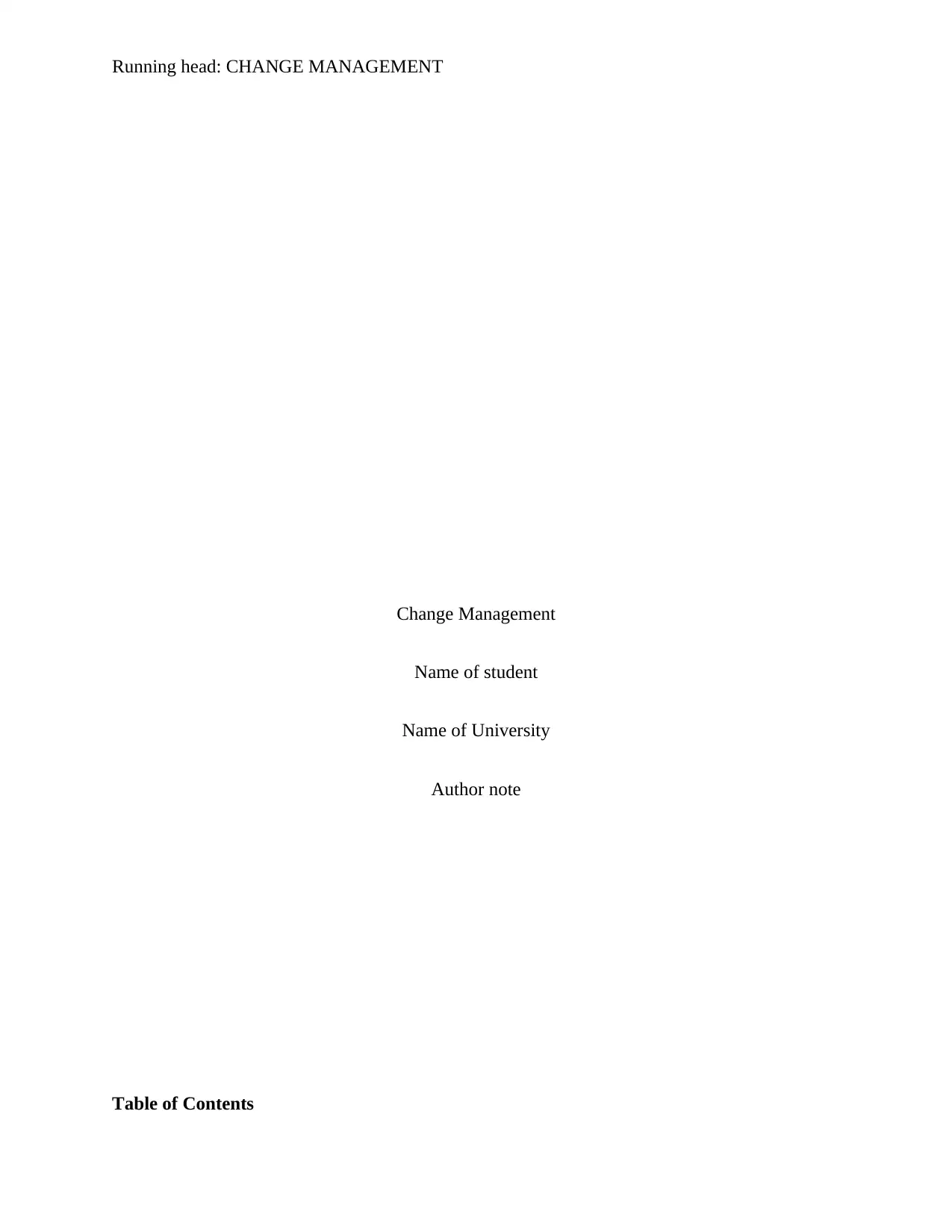
Running head: CHANGE MANAGEMENT
Change Management
Name of student
Name of University
Author note
Table of Contents
Change Management
Name of student
Name of University
Author note
Table of Contents
Paraphrase This Document
Need a fresh take? Get an instant paraphrase of this document with our AI Paraphraser
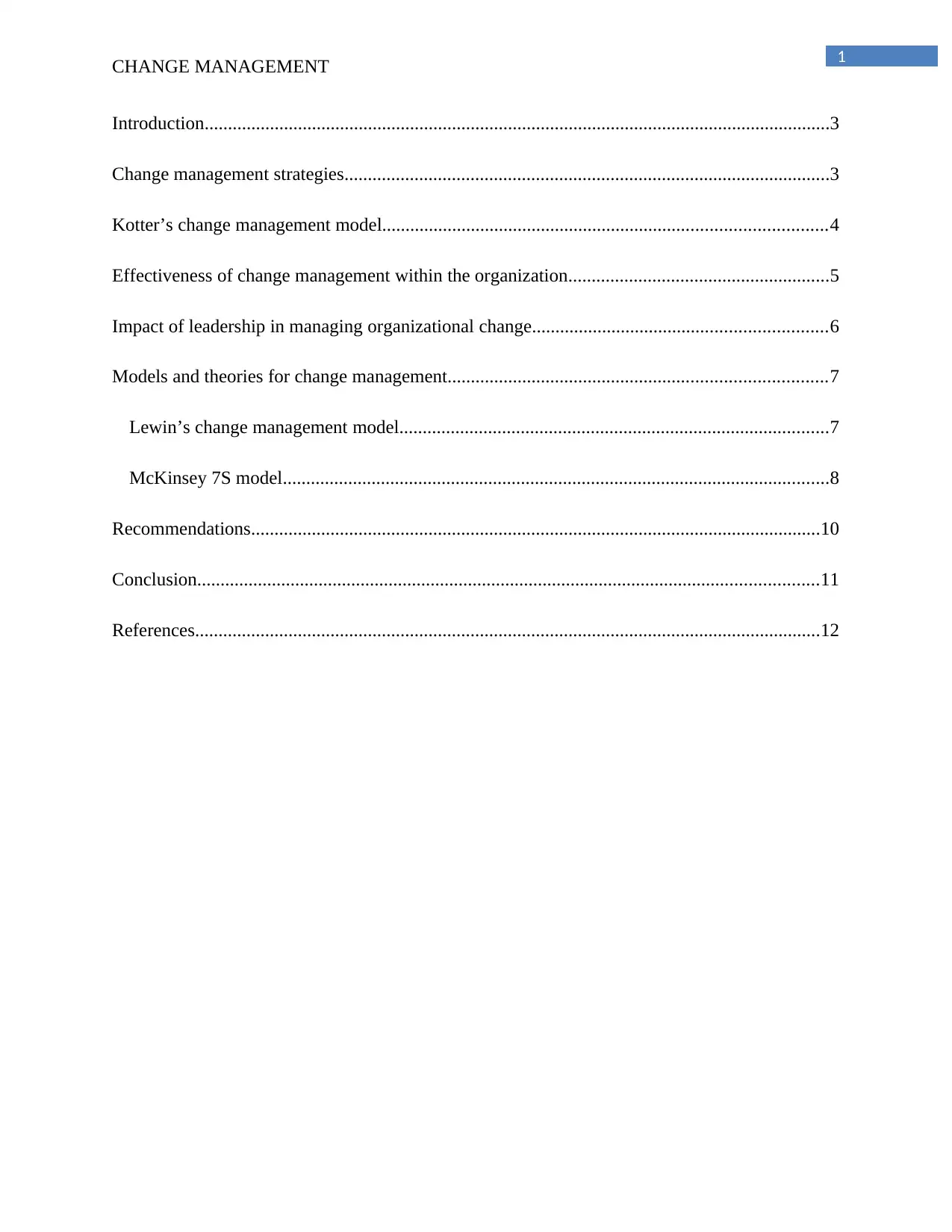
1
CHANGE MANAGEMENT
Introduction......................................................................................................................................3
Change management strategies........................................................................................................3
Kotter’s change management model...............................................................................................4
Effectiveness of change management within the organization........................................................5
Impact of leadership in managing organizational change...............................................................6
Models and theories for change management.................................................................................7
Lewin’s change management model............................................................................................7
McKinsey 7S model.....................................................................................................................8
Recommendations..........................................................................................................................10
Conclusion.....................................................................................................................................11
References......................................................................................................................................12
CHANGE MANAGEMENT
Introduction......................................................................................................................................3
Change management strategies........................................................................................................3
Kotter’s change management model...............................................................................................4
Effectiveness of change management within the organization........................................................5
Impact of leadership in managing organizational change...............................................................6
Models and theories for change management.................................................................................7
Lewin’s change management model............................................................................................7
McKinsey 7S model.....................................................................................................................8
Recommendations..........................................................................................................................10
Conclusion.....................................................................................................................................11
References......................................................................................................................................12
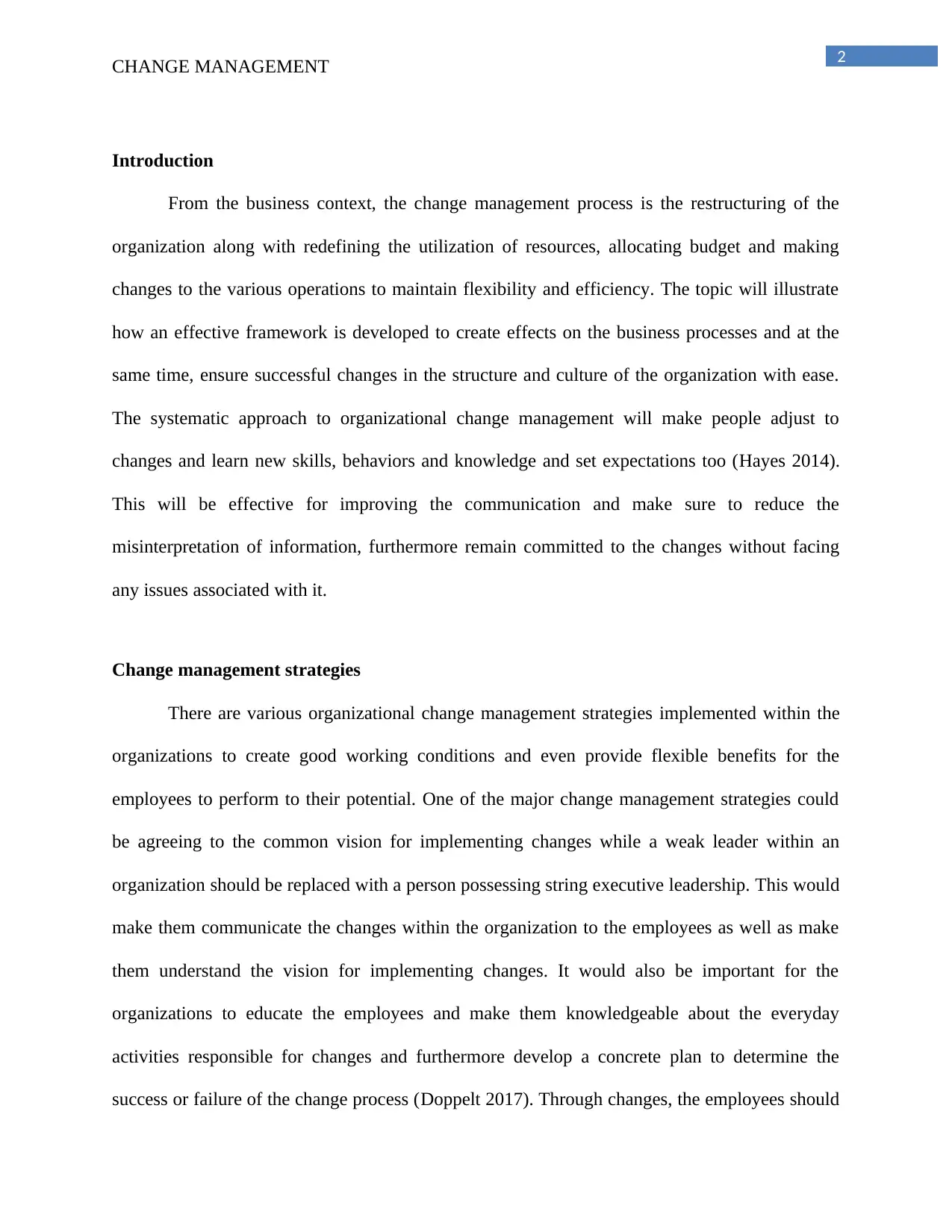
2
CHANGE MANAGEMENT
Introduction
From the business context, the change management process is the restructuring of the
organization along with redefining the utilization of resources, allocating budget and making
changes to the various operations to maintain flexibility and efficiency. The topic will illustrate
how an effective framework is developed to create effects on the business processes and at the
same time, ensure successful changes in the structure and culture of the organization with ease.
The systematic approach to organizational change management will make people adjust to
changes and learn new skills, behaviors and knowledge and set expectations too (Hayes 2014).
This will be effective for improving the communication and make sure to reduce the
misinterpretation of information, furthermore remain committed to the changes without facing
any issues associated with it.
Change management strategies
There are various organizational change management strategies implemented within the
organizations to create good working conditions and even provide flexible benefits for the
employees to perform to their potential. One of the major change management strategies could
be agreeing to the common vision for implementing changes while a weak leader within an
organization should be replaced with a person possessing string executive leadership. This would
make them communicate the changes within the organization to the employees as well as make
them understand the vision for implementing changes. It would also be important for the
organizations to educate the employees and make them knowledgeable about the everyday
activities responsible for changes and furthermore develop a concrete plan to determine the
success or failure of the change process (Doppelt 2017). Through changes, the employees should
CHANGE MANAGEMENT
Introduction
From the business context, the change management process is the restructuring of the
organization along with redefining the utilization of resources, allocating budget and making
changes to the various operations to maintain flexibility and efficiency. The topic will illustrate
how an effective framework is developed to create effects on the business processes and at the
same time, ensure successful changes in the structure and culture of the organization with ease.
The systematic approach to organizational change management will make people adjust to
changes and learn new skills, behaviors and knowledge and set expectations too (Hayes 2014).
This will be effective for improving the communication and make sure to reduce the
misinterpretation of information, furthermore remain committed to the changes without facing
any issues associated with it.
Change management strategies
There are various organizational change management strategies implemented within the
organizations to create good working conditions and even provide flexible benefits for the
employees to perform to their potential. One of the major change management strategies could
be agreeing to the common vision for implementing changes while a weak leader within an
organization should be replaced with a person possessing string executive leadership. This would
make them communicate the changes within the organization to the employees as well as make
them understand the vision for implementing changes. It would also be important for the
organizations to educate the employees and make them knowledgeable about the everyday
activities responsible for changes and furthermore develop a concrete plan to determine the
success or failure of the change process (Doppelt 2017). Through changes, the employees should
⊘ This is a preview!⊘
Do you want full access?
Subscribe today to unlock all pages.

Trusted by 1+ million students worldwide
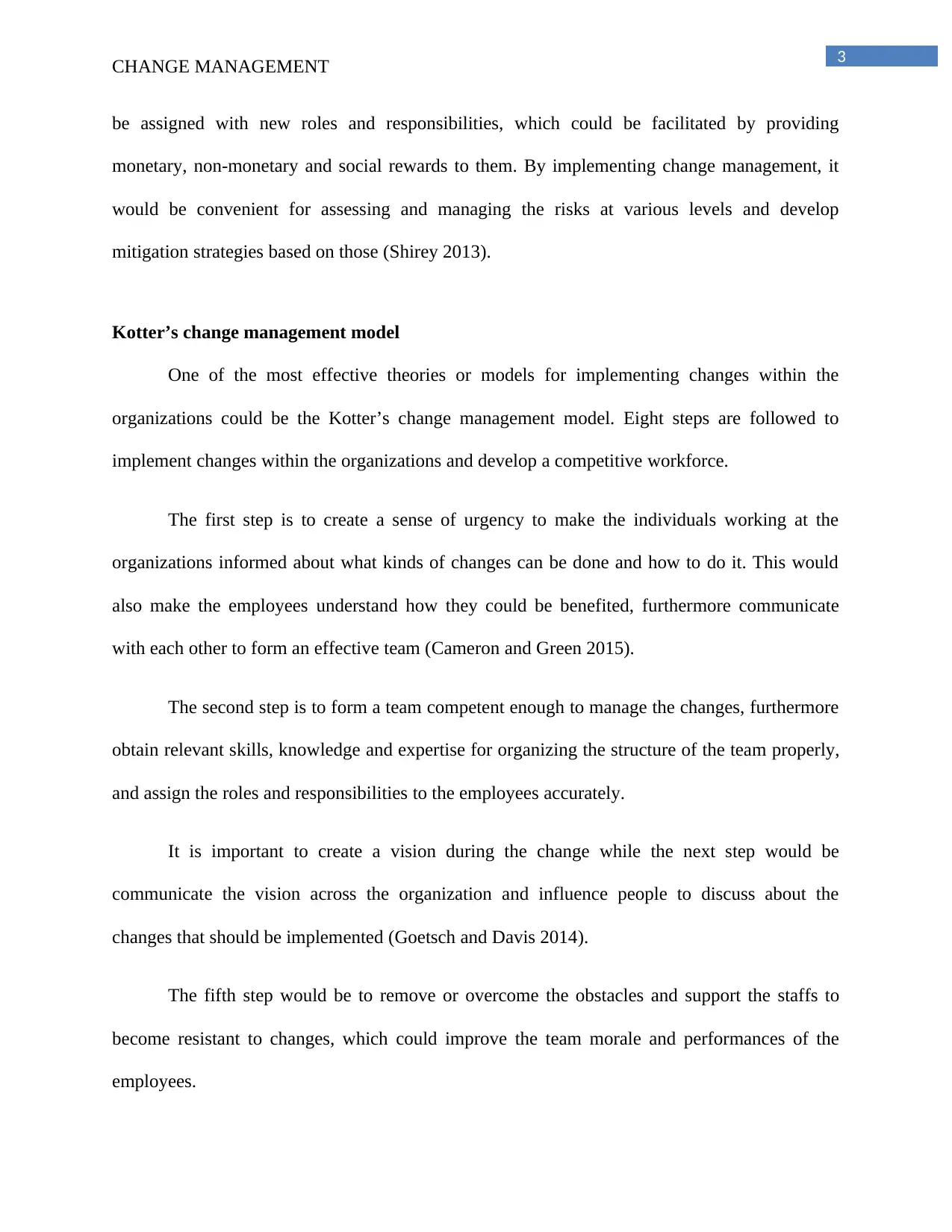
3
CHANGE MANAGEMENT
be assigned with new roles and responsibilities, which could be facilitated by providing
monetary, non-monetary and social rewards to them. By implementing change management, it
would be convenient for assessing and managing the risks at various levels and develop
mitigation strategies based on those (Shirey 2013).
Kotter’s change management model
One of the most effective theories or models for implementing changes within the
organizations could be the Kotter’s change management model. Eight steps are followed to
implement changes within the organizations and develop a competitive workforce.
The first step is to create a sense of urgency to make the individuals working at the
organizations informed about what kinds of changes can be done and how to do it. This would
also make the employees understand how they could be benefited, furthermore communicate
with each other to form an effective team (Cameron and Green 2015).
The second step is to form a team competent enough to manage the changes, furthermore
obtain relevant skills, knowledge and expertise for organizing the structure of the team properly,
and assign the roles and responsibilities to the employees accurately.
It is important to create a vision during the change while the next step would be
communicate the vision across the organization and influence people to discuss about the
changes that should be implemented (Goetsch and Davis 2014).
The fifth step would be to remove or overcome the obstacles and support the staffs to
become resistant to changes, which could improve the team morale and performances of the
employees.
CHANGE MANAGEMENT
be assigned with new roles and responsibilities, which could be facilitated by providing
monetary, non-monetary and social rewards to them. By implementing change management, it
would be convenient for assessing and managing the risks at various levels and develop
mitigation strategies based on those (Shirey 2013).
Kotter’s change management model
One of the most effective theories or models for implementing changes within the
organizations could be the Kotter’s change management model. Eight steps are followed to
implement changes within the organizations and develop a competitive workforce.
The first step is to create a sense of urgency to make the individuals working at the
organizations informed about what kinds of changes can be done and how to do it. This would
also make the employees understand how they could be benefited, furthermore communicate
with each other to form an effective team (Cameron and Green 2015).
The second step is to form a team competent enough to manage the changes, furthermore
obtain relevant skills, knowledge and expertise for organizing the structure of the team properly,
and assign the roles and responsibilities to the employees accurately.
It is important to create a vision during the change while the next step would be
communicate the vision across the organization and influence people to discuss about the
changes that should be implemented (Goetsch and Davis 2014).
The fifth step would be to remove or overcome the obstacles and support the staffs to
become resistant to changes, which could improve the team morale and performances of the
employees.
Paraphrase This Document
Need a fresh take? Get an instant paraphrase of this document with our AI Paraphraser
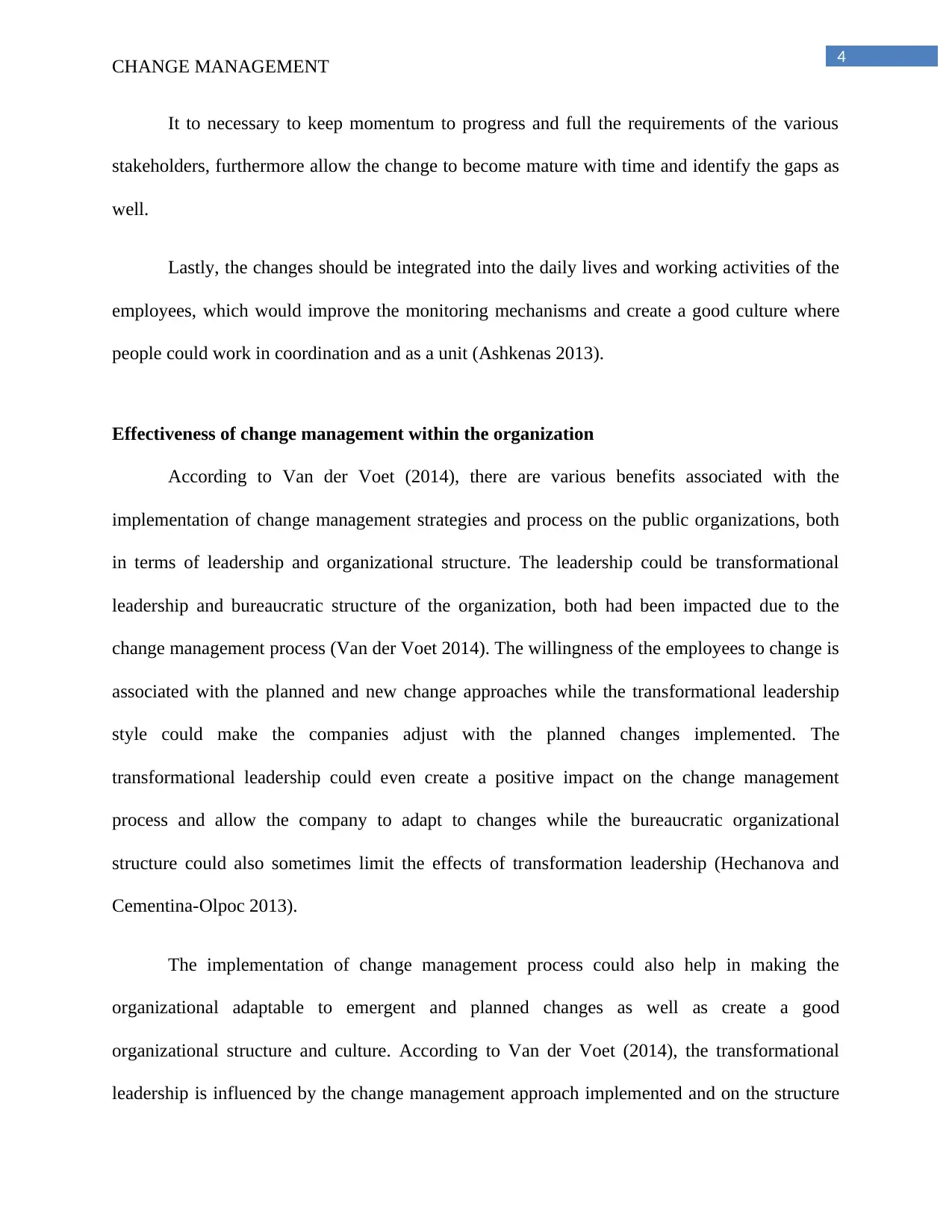
4
CHANGE MANAGEMENT
It to necessary to keep momentum to progress and full the requirements of the various
stakeholders, furthermore allow the change to become mature with time and identify the gaps as
well.
Lastly, the changes should be integrated into the daily lives and working activities of the
employees, which would improve the monitoring mechanisms and create a good culture where
people could work in coordination and as a unit (Ashkenas 2013).
Effectiveness of change management within the organization
According to Van der Voet (2014), there are various benefits associated with the
implementation of change management strategies and process on the public organizations, both
in terms of leadership and organizational structure. The leadership could be transformational
leadership and bureaucratic structure of the organization, both had been impacted due to the
change management process (Van der Voet 2014). The willingness of the employees to change is
associated with the planned and new change approaches while the transformational leadership
style could make the companies adjust with the planned changes implemented. The
transformational leadership could even create a positive impact on the change management
process and allow the company to adapt to changes while the bureaucratic organizational
structure could also sometimes limit the effects of transformation leadership (Hechanova and
Cementina-Olpoc 2013).
The implementation of change management process could also help in making the
organizational adaptable to emergent and planned changes as well as create a good
organizational structure and culture. According to Van der Voet (2014), the transformational
leadership is influenced by the change management approach implemented and on the structure
CHANGE MANAGEMENT
It to necessary to keep momentum to progress and full the requirements of the various
stakeholders, furthermore allow the change to become mature with time and identify the gaps as
well.
Lastly, the changes should be integrated into the daily lives and working activities of the
employees, which would improve the monitoring mechanisms and create a good culture where
people could work in coordination and as a unit (Ashkenas 2013).
Effectiveness of change management within the organization
According to Van der Voet (2014), there are various benefits associated with the
implementation of change management strategies and process on the public organizations, both
in terms of leadership and organizational structure. The leadership could be transformational
leadership and bureaucratic structure of the organization, both had been impacted due to the
change management process (Van der Voet 2014). The willingness of the employees to change is
associated with the planned and new change approaches while the transformational leadership
style could make the companies adjust with the planned changes implemented. The
transformational leadership could even create a positive impact on the change management
process and allow the company to adapt to changes while the bureaucratic organizational
structure could also sometimes limit the effects of transformation leadership (Hechanova and
Cementina-Olpoc 2013).
The implementation of change management process could also help in making the
organizational adaptable to emergent and planned changes as well as create a good
organizational structure and culture. According to Van der Voet (2014), the transformational
leadership is influenced by the change management approach implemented and on the structure
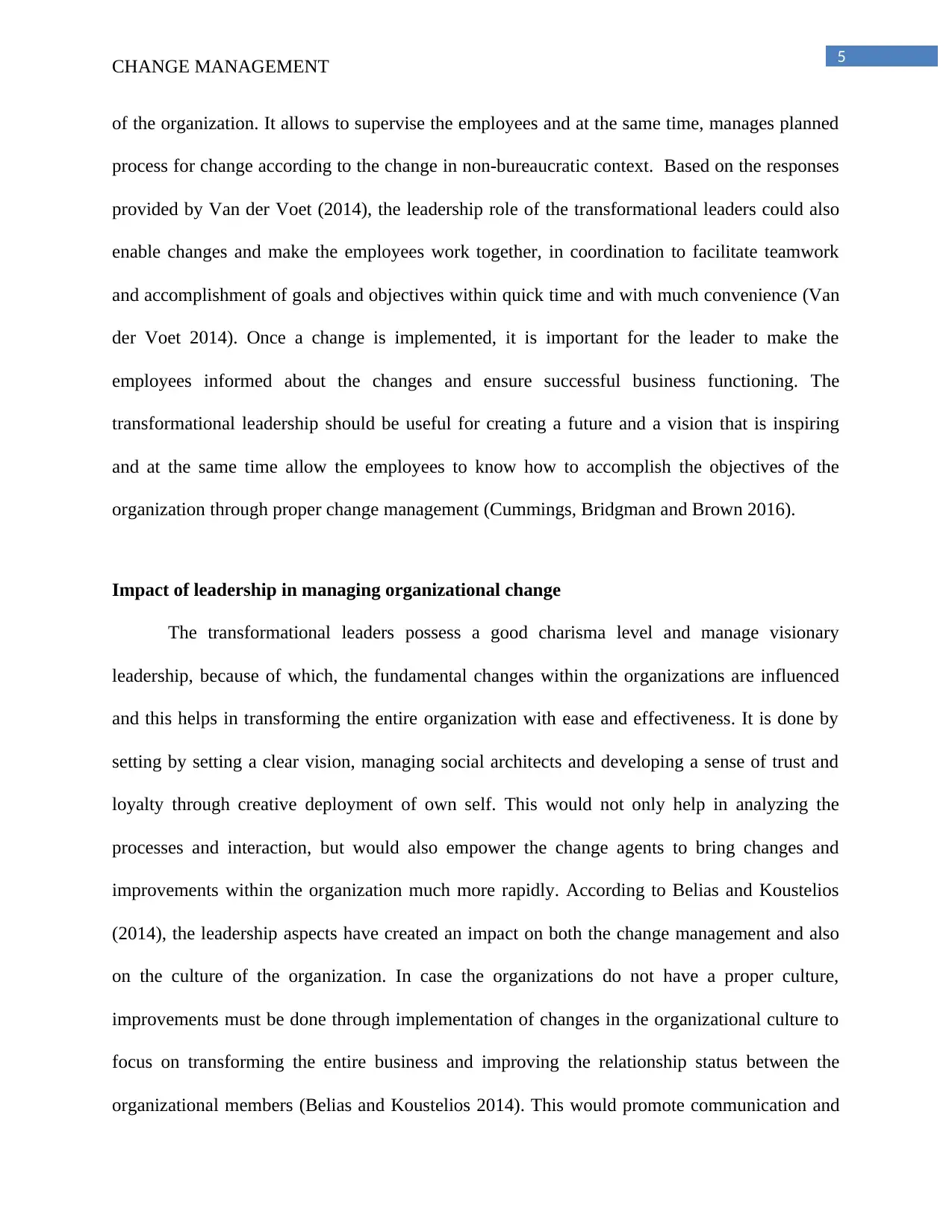
5
CHANGE MANAGEMENT
of the organization. It allows to supervise the employees and at the same time, manages planned
process for change according to the change in non-bureaucratic context. Based on the responses
provided by Van der Voet (2014), the leadership role of the transformational leaders could also
enable changes and make the employees work together, in coordination to facilitate teamwork
and accomplishment of goals and objectives within quick time and with much convenience (Van
der Voet 2014). Once a change is implemented, it is important for the leader to make the
employees informed about the changes and ensure successful business functioning. The
transformational leadership should be useful for creating a future and a vision that is inspiring
and at the same time allow the employees to know how to accomplish the objectives of the
organization through proper change management (Cummings, Bridgman and Brown 2016).
Impact of leadership in managing organizational change
The transformational leaders possess a good charisma level and manage visionary
leadership, because of which, the fundamental changes within the organizations are influenced
and this helps in transforming the entire organization with ease and effectiveness. It is done by
setting by setting a clear vision, managing social architects and developing a sense of trust and
loyalty through creative deployment of own self. This would not only help in analyzing the
processes and interaction, but would also empower the change agents to bring changes and
improvements within the organization much more rapidly. According to Belias and Koustelios
(2014), the leadership aspects have created an impact on both the change management and also
on the culture of the organization. In case the organizations do not have a proper culture,
improvements must be done through implementation of changes in the organizational culture to
focus on transforming the entire business and improving the relationship status between the
organizational members (Belias and Koustelios 2014). This would promote communication and
CHANGE MANAGEMENT
of the organization. It allows to supervise the employees and at the same time, manages planned
process for change according to the change in non-bureaucratic context. Based on the responses
provided by Van der Voet (2014), the leadership role of the transformational leaders could also
enable changes and make the employees work together, in coordination to facilitate teamwork
and accomplishment of goals and objectives within quick time and with much convenience (Van
der Voet 2014). Once a change is implemented, it is important for the leader to make the
employees informed about the changes and ensure successful business functioning. The
transformational leadership should be useful for creating a future and a vision that is inspiring
and at the same time allow the employees to know how to accomplish the objectives of the
organization through proper change management (Cummings, Bridgman and Brown 2016).
Impact of leadership in managing organizational change
The transformational leaders possess a good charisma level and manage visionary
leadership, because of which, the fundamental changes within the organizations are influenced
and this helps in transforming the entire organization with ease and effectiveness. It is done by
setting by setting a clear vision, managing social architects and developing a sense of trust and
loyalty through creative deployment of own self. This would not only help in analyzing the
processes and interaction, but would also empower the change agents to bring changes and
improvements within the organization much more rapidly. According to Belias and Koustelios
(2014), the leadership aspects have created an impact on both the change management and also
on the culture of the organization. In case the organizations do not have a proper culture,
improvements must be done through implementation of changes in the organizational culture to
focus on transforming the entire business and improving the relationship status between the
organizational members (Belias and Koustelios 2014). This would promote communication and
⊘ This is a preview!⊘
Do you want full access?
Subscribe today to unlock all pages.

Trusted by 1+ million students worldwide
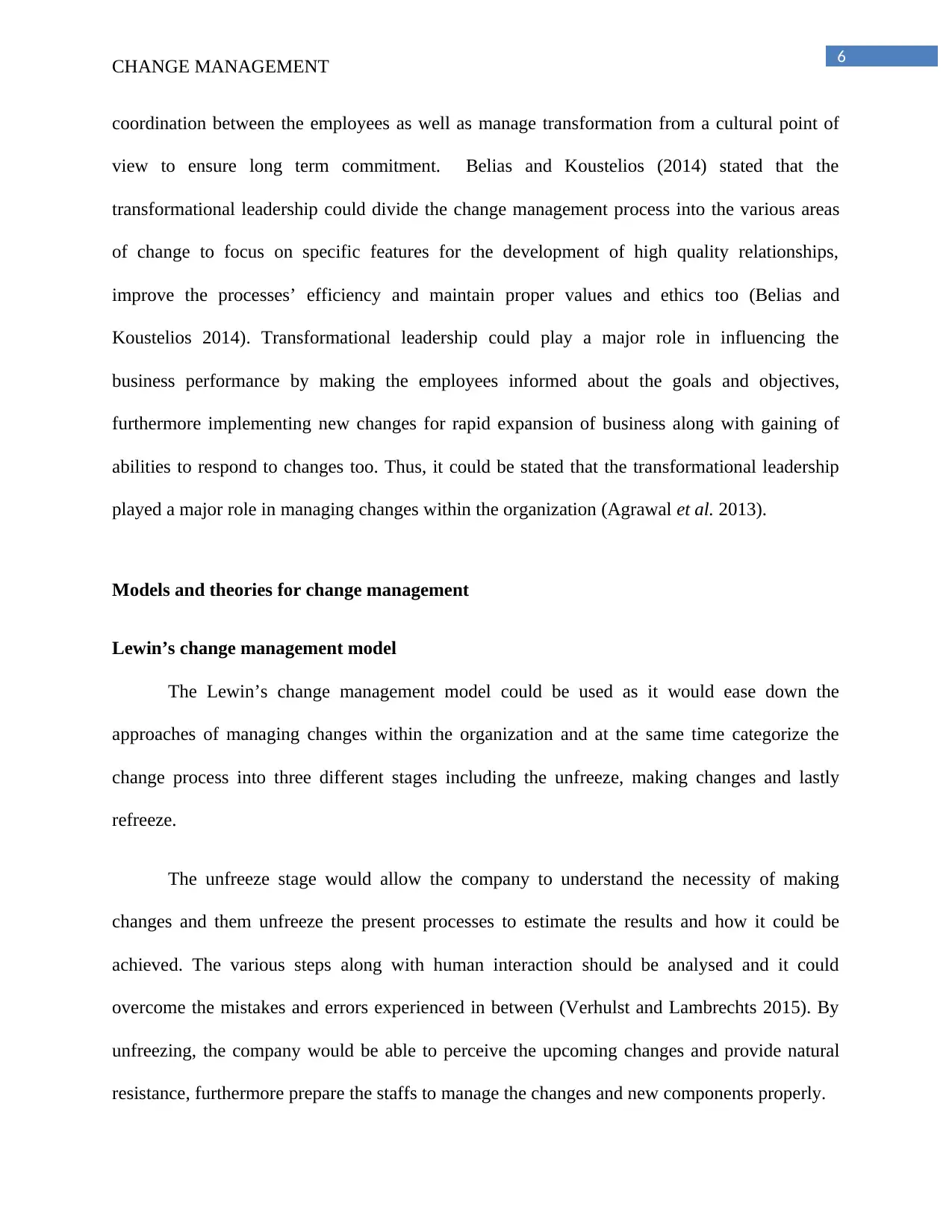
6
CHANGE MANAGEMENT
coordination between the employees as well as manage transformation from a cultural point of
view to ensure long term commitment. Belias and Koustelios (2014) stated that the
transformational leadership could divide the change management process into the various areas
of change to focus on specific features for the development of high quality relationships,
improve the processes’ efficiency and maintain proper values and ethics too (Belias and
Koustelios 2014). Transformational leadership could play a major role in influencing the
business performance by making the employees informed about the goals and objectives,
furthermore implementing new changes for rapid expansion of business along with gaining of
abilities to respond to changes too. Thus, it could be stated that the transformational leadership
played a major role in managing changes within the organization (Agrawal et al. 2013).
Models and theories for change management
Lewin’s change management model
The Lewin’s change management model could be used as it would ease down the
approaches of managing changes within the organization and at the same time categorize the
change process into three different stages including the unfreeze, making changes and lastly
refreeze.
The unfreeze stage would allow the company to understand the necessity of making
changes and them unfreeze the present processes to estimate the results and how it could be
achieved. The various steps along with human interaction should be analysed and it could
overcome the mistakes and errors experienced in between (Verhulst and Lambrechts 2015). By
unfreezing, the company would be able to perceive the upcoming changes and provide natural
resistance, furthermore prepare the staffs to manage the changes and new components properly.
CHANGE MANAGEMENT
coordination between the employees as well as manage transformation from a cultural point of
view to ensure long term commitment. Belias and Koustelios (2014) stated that the
transformational leadership could divide the change management process into the various areas
of change to focus on specific features for the development of high quality relationships,
improve the processes’ efficiency and maintain proper values and ethics too (Belias and
Koustelios 2014). Transformational leadership could play a major role in influencing the
business performance by making the employees informed about the goals and objectives,
furthermore implementing new changes for rapid expansion of business along with gaining of
abilities to respond to changes too. Thus, it could be stated that the transformational leadership
played a major role in managing changes within the organization (Agrawal et al. 2013).
Models and theories for change management
Lewin’s change management model
The Lewin’s change management model could be used as it would ease down the
approaches of managing changes within the organization and at the same time categorize the
change process into three different stages including the unfreeze, making changes and lastly
refreeze.
The unfreeze stage would allow the company to understand the necessity of making
changes and them unfreeze the present processes to estimate the results and how it could be
achieved. The various steps along with human interaction should be analysed and it could
overcome the mistakes and errors experienced in between (Verhulst and Lambrechts 2015). By
unfreezing, the company would be able to perceive the upcoming changes and provide natural
resistance, furthermore prepare the staffs to manage the changes and new components properly.
Paraphrase This Document
Need a fresh take? Get an instant paraphrase of this document with our AI Paraphraser
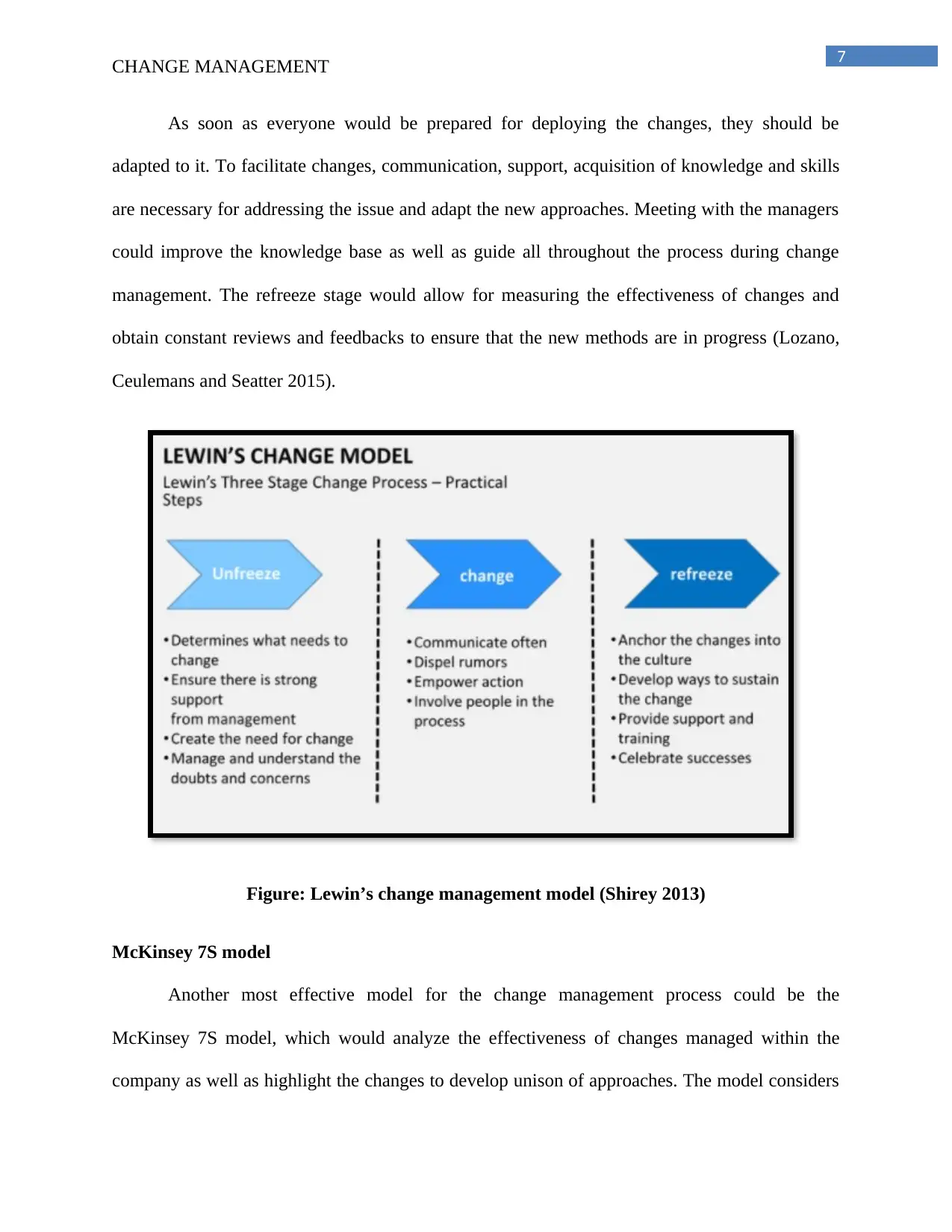
7
CHANGE MANAGEMENT
As soon as everyone would be prepared for deploying the changes, they should be
adapted to it. To facilitate changes, communication, support, acquisition of knowledge and skills
are necessary for addressing the issue and adapt the new approaches. Meeting with the managers
could improve the knowledge base as well as guide all throughout the process during change
management. The refreeze stage would allow for measuring the effectiveness of changes and
obtain constant reviews and feedbacks to ensure that the new methods are in progress (Lozano,
Ceulemans and Seatter 2015).
Figure: Lewin’s change management model (Shirey 2013)
McKinsey 7S model
Another most effective model for the change management process could be the
McKinsey 7S model, which would analyze the effectiveness of changes managed within the
company as well as highlight the changes to develop unison of approaches. The model considers
CHANGE MANAGEMENT
As soon as everyone would be prepared for deploying the changes, they should be
adapted to it. To facilitate changes, communication, support, acquisition of knowledge and skills
are necessary for addressing the issue and adapt the new approaches. Meeting with the managers
could improve the knowledge base as well as guide all throughout the process during change
management. The refreeze stage would allow for measuring the effectiveness of changes and
obtain constant reviews and feedbacks to ensure that the new methods are in progress (Lozano,
Ceulemans and Seatter 2015).
Figure: Lewin’s change management model (Shirey 2013)
McKinsey 7S model
Another most effective model for the change management process could be the
McKinsey 7S model, which would analyze the effectiveness of changes managed within the
company as well as highlight the changes to develop unison of approaches. The model considers
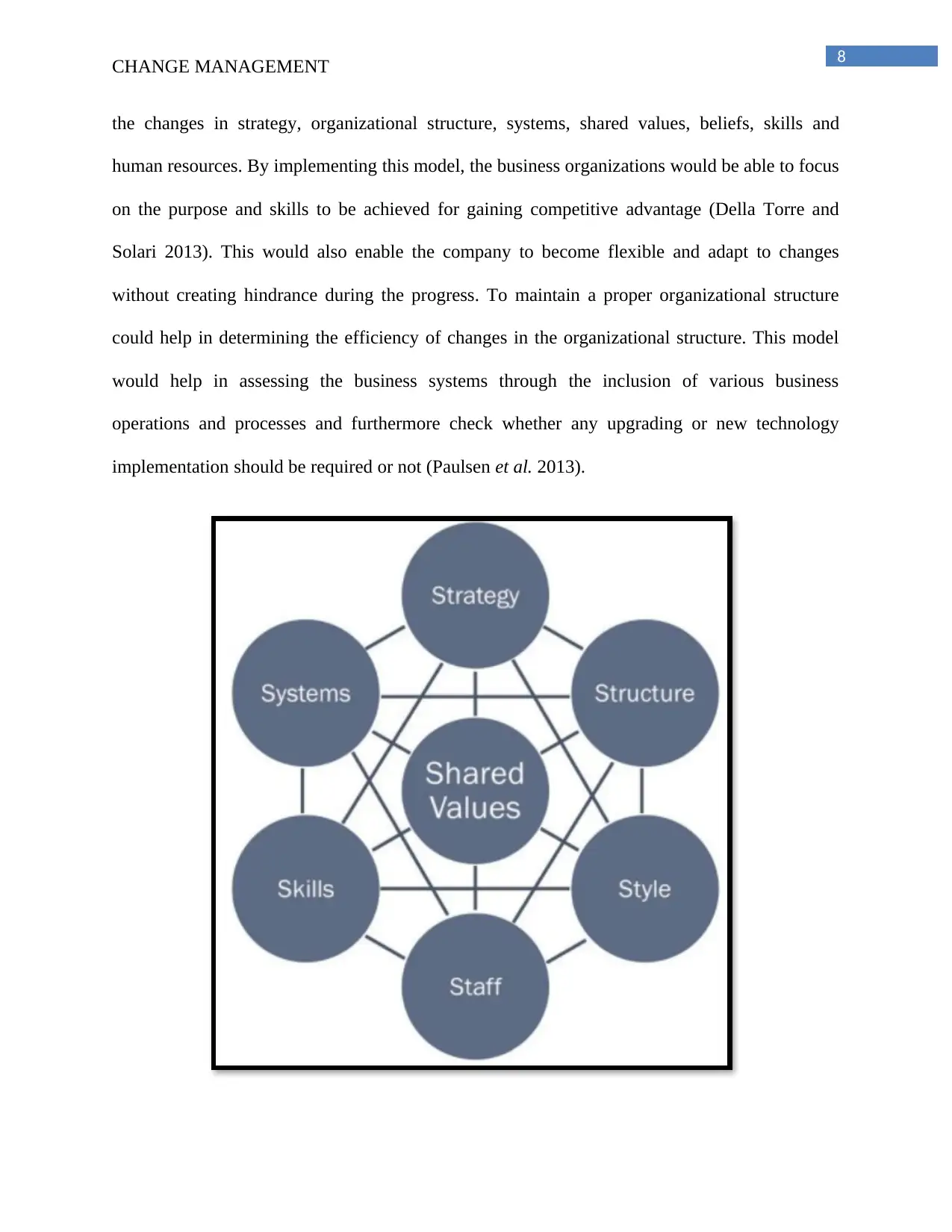
8
CHANGE MANAGEMENT
the changes in strategy, organizational structure, systems, shared values, beliefs, skills and
human resources. By implementing this model, the business organizations would be able to focus
on the purpose and skills to be achieved for gaining competitive advantage (Della Torre and
Solari 2013). This would also enable the company to become flexible and adapt to changes
without creating hindrance during the progress. To maintain a proper organizational structure
could help in determining the efficiency of changes in the organizational structure. This model
would help in assessing the business systems through the inclusion of various business
operations and processes and furthermore check whether any upgrading or new technology
implementation should be required or not (Paulsen et al. 2013).
CHANGE MANAGEMENT
the changes in strategy, organizational structure, systems, shared values, beliefs, skills and
human resources. By implementing this model, the business organizations would be able to focus
on the purpose and skills to be achieved for gaining competitive advantage (Della Torre and
Solari 2013). This would also enable the company to become flexible and adapt to changes
without creating hindrance during the progress. To maintain a proper organizational structure
could help in determining the efficiency of changes in the organizational structure. This model
would help in assessing the business systems through the inclusion of various business
operations and processes and furthermore check whether any upgrading or new technology
implementation should be required or not (Paulsen et al. 2013).
⊘ This is a preview!⊘
Do you want full access?
Subscribe today to unlock all pages.

Trusted by 1+ million students worldwide
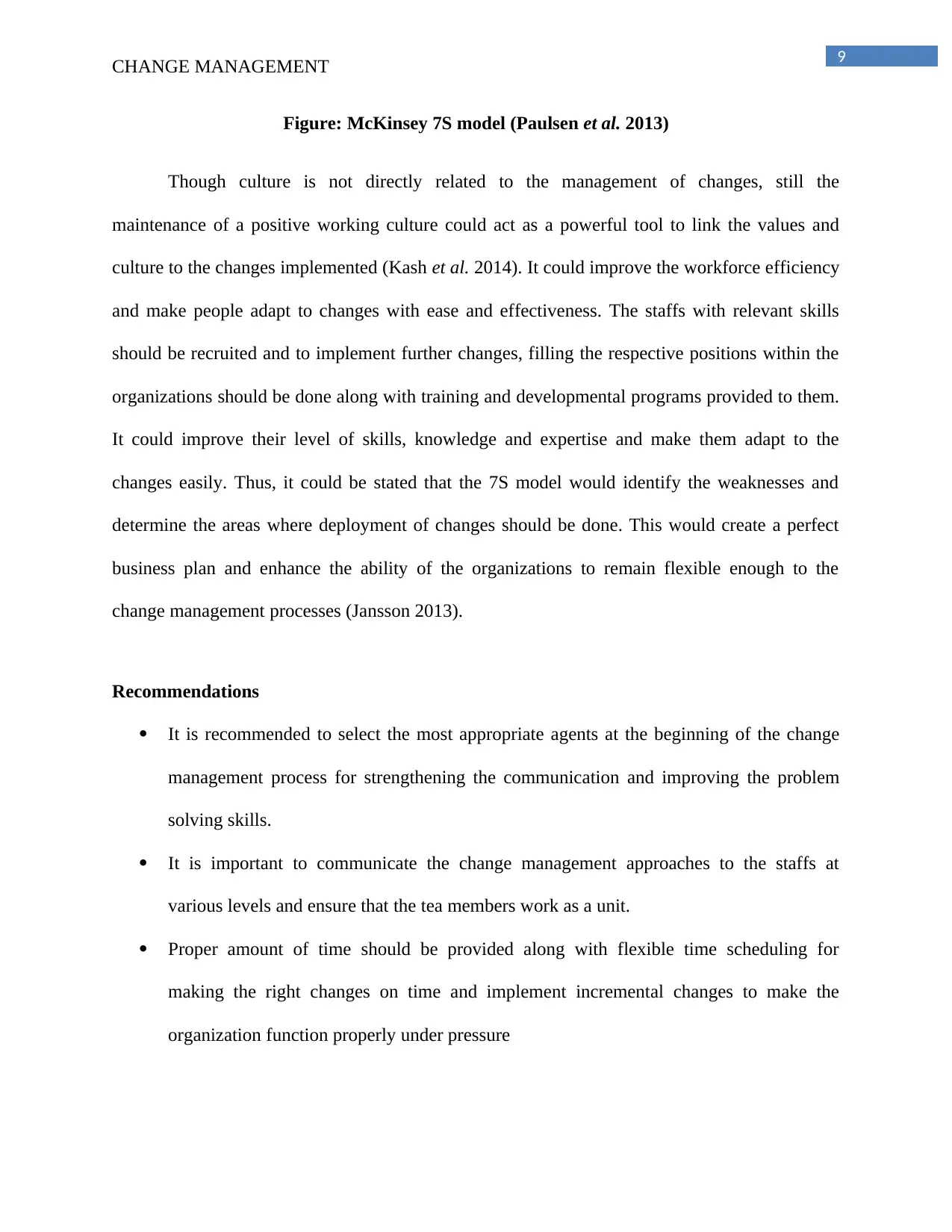
9
CHANGE MANAGEMENT
Figure: McKinsey 7S model (Paulsen et al. 2013)
Though culture is not directly related to the management of changes, still the
maintenance of a positive working culture could act as a powerful tool to link the values and
culture to the changes implemented (Kash et al. 2014). It could improve the workforce efficiency
and make people adapt to changes with ease and effectiveness. The staffs with relevant skills
should be recruited and to implement further changes, filling the respective positions within the
organizations should be done along with training and developmental programs provided to them.
It could improve their level of skills, knowledge and expertise and make them adapt to the
changes easily. Thus, it could be stated that the 7S model would identify the weaknesses and
determine the areas where deployment of changes should be done. This would create a perfect
business plan and enhance the ability of the organizations to remain flexible enough to the
change management processes (Jansson 2013).
Recommendations
It is recommended to select the most appropriate agents at the beginning of the change
management process for strengthening the communication and improving the problem
solving skills.
It is important to communicate the change management approaches to the staffs at
various levels and ensure that the tea members work as a unit.
Proper amount of time should be provided along with flexible time scheduling for
making the right changes on time and implement incremental changes to make the
organization function properly under pressure
CHANGE MANAGEMENT
Figure: McKinsey 7S model (Paulsen et al. 2013)
Though culture is not directly related to the management of changes, still the
maintenance of a positive working culture could act as a powerful tool to link the values and
culture to the changes implemented (Kash et al. 2014). It could improve the workforce efficiency
and make people adapt to changes with ease and effectiveness. The staffs with relevant skills
should be recruited and to implement further changes, filling the respective positions within the
organizations should be done along with training and developmental programs provided to them.
It could improve their level of skills, knowledge and expertise and make them adapt to the
changes easily. Thus, it could be stated that the 7S model would identify the weaknesses and
determine the areas where deployment of changes should be done. This would create a perfect
business plan and enhance the ability of the organizations to remain flexible enough to the
change management processes (Jansson 2013).
Recommendations
It is recommended to select the most appropriate agents at the beginning of the change
management process for strengthening the communication and improving the problem
solving skills.
It is important to communicate the change management approaches to the staffs at
various levels and ensure that the tea members work as a unit.
Proper amount of time should be provided along with flexible time scheduling for
making the right changes on time and implement incremental changes to make the
organization function properly under pressure
Paraphrase This Document
Need a fresh take? Get an instant paraphrase of this document with our AI Paraphraser
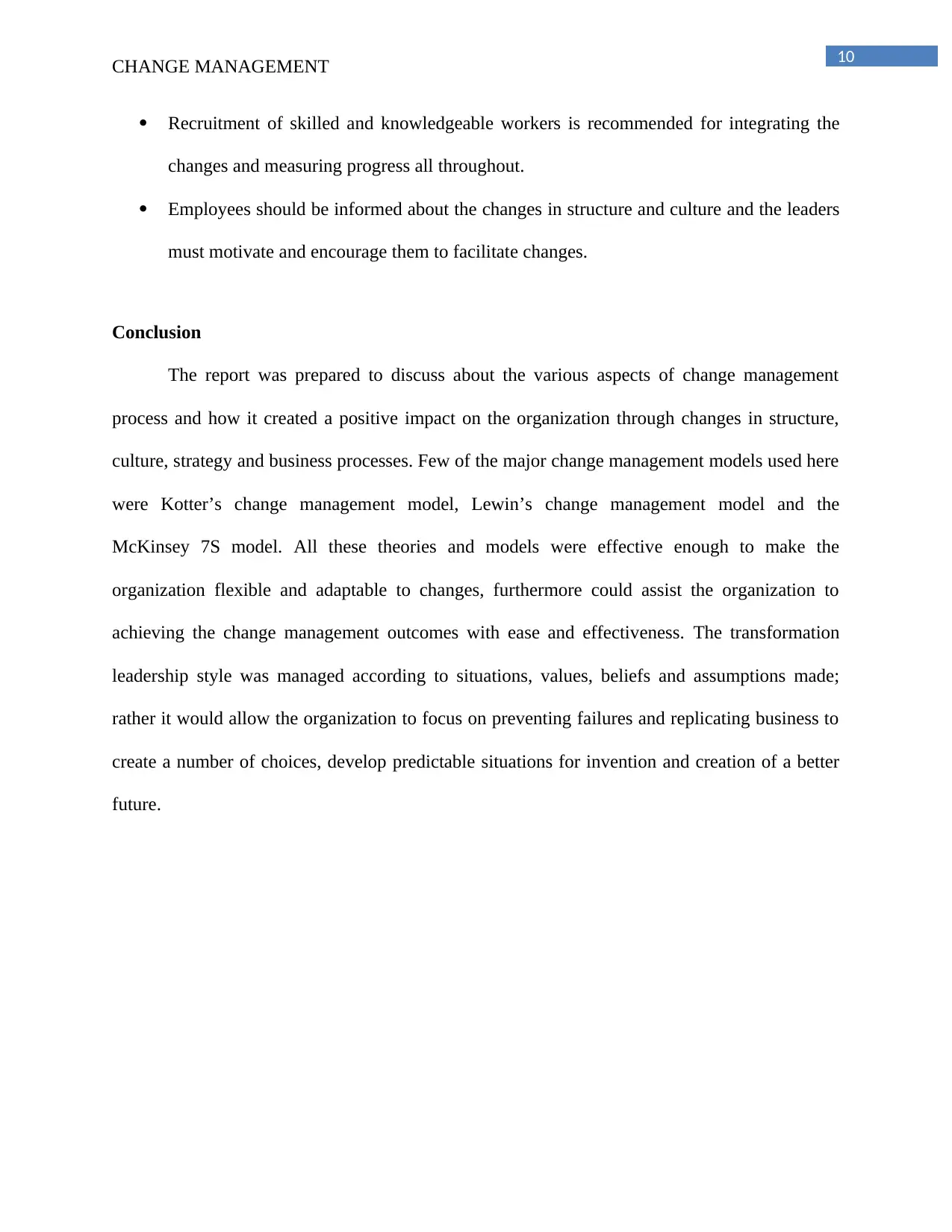
10
CHANGE MANAGEMENT
Recruitment of skilled and knowledgeable workers is recommended for integrating the
changes and measuring progress all throughout.
Employees should be informed about the changes in structure and culture and the leaders
must motivate and encourage them to facilitate changes.
Conclusion
The report was prepared to discuss about the various aspects of change management
process and how it created a positive impact on the organization through changes in structure,
culture, strategy and business processes. Few of the major change management models used here
were Kotter’s change management model, Lewin’s change management model and the
McKinsey 7S model. All these theories and models were effective enough to make the
organization flexible and adaptable to changes, furthermore could assist the organization to
achieving the change management outcomes with ease and effectiveness. The transformation
leadership style was managed according to situations, values, beliefs and assumptions made;
rather it would allow the organization to focus on preventing failures and replicating business to
create a number of choices, develop predictable situations for invention and creation of a better
future.
CHANGE MANAGEMENT
Recruitment of skilled and knowledgeable workers is recommended for integrating the
changes and measuring progress all throughout.
Employees should be informed about the changes in structure and culture and the leaders
must motivate and encourage them to facilitate changes.
Conclusion
The report was prepared to discuss about the various aspects of change management
process and how it created a positive impact on the organization through changes in structure,
culture, strategy and business processes. Few of the major change management models used here
were Kotter’s change management model, Lewin’s change management model and the
McKinsey 7S model. All these theories and models were effective enough to make the
organization flexible and adaptable to changes, furthermore could assist the organization to
achieving the change management outcomes with ease and effectiveness. The transformation
leadership style was managed according to situations, values, beliefs and assumptions made;
rather it would allow the organization to focus on preventing failures and replicating business to
create a number of choices, develop predictable situations for invention and creation of a better
future.
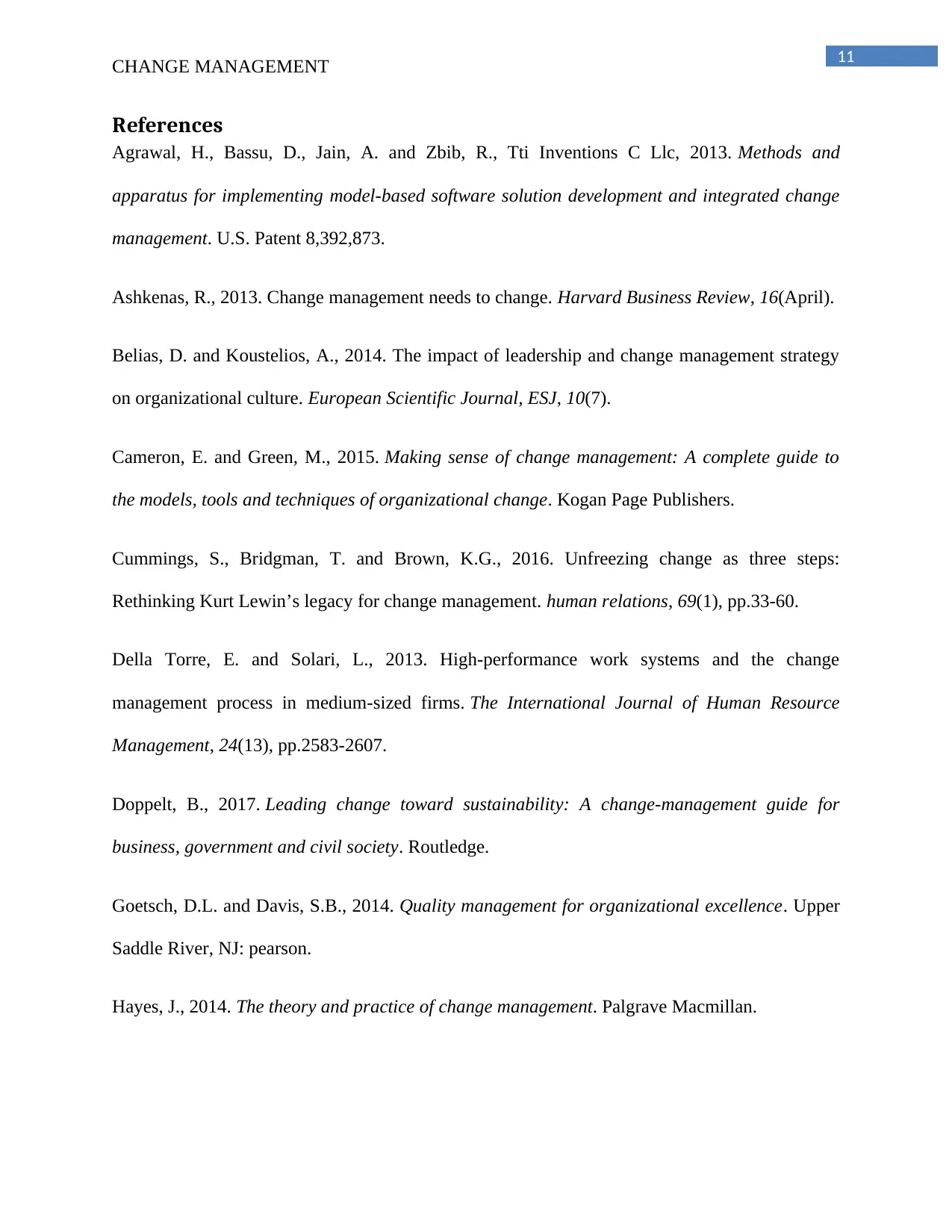
11
CHANGE MANAGEMENT
References
Agrawal, H., Bassu, D., Jain, A. and Zbib, R., Tti Inventions C Llc, 2013. Methods and
apparatus for implementing model-based software solution development and integrated change
management. U.S. Patent 8,392,873.
Ashkenas, R., 2013. Change management needs to change. Harvard Business Review, 16(April).
Belias, D. and Koustelios, A., 2014. The impact of leadership and change management strategy
on organizational culture. European Scientific Journal, ESJ, 10(7).
Cameron, E. and Green, M., 2015. Making sense of change management: A complete guide to
the models, tools and techniques of organizational change. Kogan Page Publishers.
Cummings, S., Bridgman, T. and Brown, K.G., 2016. Unfreezing change as three steps:
Rethinking Kurt Lewin’s legacy for change management. human relations, 69(1), pp.33-60.
Della Torre, E. and Solari, L., 2013. High-performance work systems and the change
management process in medium-sized firms. The International Journal of Human Resource
Management, 24(13), pp.2583-2607.
Doppelt, B., 2017. Leading change toward sustainability: A change-management guide for
business, government and civil society. Routledge.
Goetsch, D.L. and Davis, S.B., 2014. Quality management for organizational excellence. Upper
Saddle River, NJ: pearson.
Hayes, J., 2014. The theory and practice of change management. Palgrave Macmillan.
CHANGE MANAGEMENT
References
Agrawal, H., Bassu, D., Jain, A. and Zbib, R., Tti Inventions C Llc, 2013. Methods and
apparatus for implementing model-based software solution development and integrated change
management. U.S. Patent 8,392,873.
Ashkenas, R., 2013. Change management needs to change. Harvard Business Review, 16(April).
Belias, D. and Koustelios, A., 2014. The impact of leadership and change management strategy
on organizational culture. European Scientific Journal, ESJ, 10(7).
Cameron, E. and Green, M., 2015. Making sense of change management: A complete guide to
the models, tools and techniques of organizational change. Kogan Page Publishers.
Cummings, S., Bridgman, T. and Brown, K.G., 2016. Unfreezing change as three steps:
Rethinking Kurt Lewin’s legacy for change management. human relations, 69(1), pp.33-60.
Della Torre, E. and Solari, L., 2013. High-performance work systems and the change
management process in medium-sized firms. The International Journal of Human Resource
Management, 24(13), pp.2583-2607.
Doppelt, B., 2017. Leading change toward sustainability: A change-management guide for
business, government and civil society. Routledge.
Goetsch, D.L. and Davis, S.B., 2014. Quality management for organizational excellence. Upper
Saddle River, NJ: pearson.
Hayes, J., 2014. The theory and practice of change management. Palgrave Macmillan.
⊘ This is a preview!⊘
Do you want full access?
Subscribe today to unlock all pages.

Trusted by 1+ million students worldwide
1 out of 14
Related Documents
Your All-in-One AI-Powered Toolkit for Academic Success.
+13062052269
info@desklib.com
Available 24*7 on WhatsApp / Email
![[object Object]](/_next/static/media/star-bottom.7253800d.svg)
Unlock your academic potential
Copyright © 2020–2025 A2Z Services. All Rights Reserved. Developed and managed by ZUCOL.




